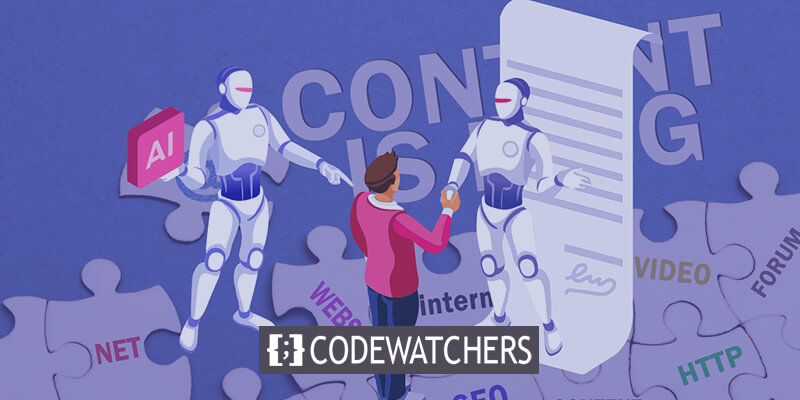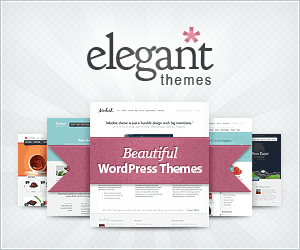Remember the thrill of churning out tons of content in minutes with AI tools like ChatGPT?

It turns out, AI-powered writing assistants hold that promise. But before you dive headfirst, brace yourself: the use of AI in content marketing can bring down your brand image.
This article isn't about fear-mongering. AI in content creation has game-changing potential. However, like any powerful tool, it demands responsible handling. So, before you unleash the robot wordsmiths, let's unpack the hidden dangers of AI content and steer clear of disaster.
Ditch the hype, embrace the facts. Buckle up, marketers, because real talk is about to begin!
Create Amazing Websites
With the best free page builder Elementor
Start NowCommon Uses of AI Content in Marketing
Artificial intelligence (AI) has revolutionized content marketing, making it more efficient and effective. Here are some common uses of AI-generated content in marketing:

Social Media Posts: Social media marketers use AI tools like ChatGPT to - generate content ideas. suggest topics, write headlines for social media posts, and schedule and optimize posts. They often use AI tools to analyze audience data to create relevant content.
Product Descriptions: AI helps create accurate and accessible product descriptions. It clearly explains functionality and features, even for non-technical audiences.
Emails: AI can assist in drafting personalized email content. It optimizes subject lines and body text for better engagement.
Images: AI tools generate visual content, such as infographics and graphics for social media. They enhance visual appeal and convey information effectively.
Blog Posts: AI can suggest blog topics, generate outlines, and even write portions of blog posts. It streamlines content creation and ensures consistency.
Landing Pages: AI helps create landing page content that resonates with the target audience. It optimizes language, layout, and calls to action.
Ebooks: AI assists in creating ebooks by suggesting content, organizing information, and even writing sections. It accelerates the ebook creation process.
Whitepapers: AI-generated whitepapers provide in-depth insights and analysis. They help establish thought leadership and credibility.
The Pitfalls of AI Marketing Content
AI content creation is exploding, promising marketers the holy grail of efficiency: pumping out content at lightning speed. But before you hand the pen (or keyboard) over to the robots, consider the potential downsides.
Quality Control Issues
Despite the hype around artificially intelligent writing, the actual results often have big problems when you take a closer look. Even though the words might seem well put together, there are serious issues with making sense, being accurate, and fitting the brand's image.

On the surface, computer-generated content has a lot of mistakes that no reputable brand would want to publish:
- Random grammar mistakes, like changing tenses or not agreeing
- Spelling errors and typos
- Messed-up formatting and problems with capital letters
But these are just the obvious problems. The real trouble comes from not making sense, like:
- Sentences that don't flow well and are too long
- Using buzzwords that don't make sense together
- Not understanding the context or using words in the wrong way
Also, automated tools can't capture a brand's personality well, so the writing might not feel like it's coming from the company:
- Inconsistent tone and messages that don't fit
- Writing that sounds robotic and doesn't connect with people
- Not trying to build a relationship or connect with customers
By focusing on getting writing done quickly instead of doing it well, marketers end up with a lot of problems. As they produce more, the mistakes pile up, from small errors to big issues with understanding and representing the brand. The gains in productivity aren't worth the damage to credibility. Rushing to use these tools might mean losing more than we gain. The real disaster could still be ahead.
Plagiarism and Duplication Risks
AI tools have a big problem with simply copying other content found online instead of writing original text. This can cause some big issues for marketers using AI without being careful.

The AI looks at lots of existing content on the web and uses it to try to write new stuff. But it often just copies too much:
- AI doesn't cite sources or give credit properly
- It simply mixes and matches passages it finds without making them unique
- AI ends up duplicating things too much
This can even turn into full plagiarism over time:
- AI keeps reusing more and more copied bits
- It fails to change the sources enough
- It ignores rules on crediting sources properly
Without fixes, marketers risk serious penalties like:
- Breaking "fair use" laws on reproduction
- Expensive lawsuits from angry creators whose work was copied
- Ruining brand reputations when caught and punished
At some point, copying becomes illegal, even if AI does not mean to plagiarize deliberately initially. Quality original writing is needed to avoid these issues.
Using AI safely means balancing speed with following rules on existing content usage. Marketers must steer carefully to stop problems before they grow out of control and do real damage. The choice is ours in use AI wisely.
Lack of Customization

A big limitation of auto-generated content is that it takes a one-size-fits-all approach that doesn’t adapt well. This fails to serve audiences uniquely.
- Generic text works poorly for specific products and services
- Does not tailor messaging to special offers or audiences
- Ignores crafting personalized customer connections
AI follows templates without deviating based on context:
- Mashes together broad topic buzzwords
- Misses opportunities to differentiate brands from competitors
- Blinds itself to reader goals, problems, or pain points
This genericness shows the tools’ lack of deeper comprehension:
- No insights on users, products, or writing purposes
- Inability to make content that fits branding strategy needs
- This means high effort to edit AI text later for targets
Customers attracted to brands through shared identity lose trust without that vision reflected back through content. If progress necessitates forsaking our core essence, have we outgrown our fundamental ethos? Can seeking scale over core values skew central priorities?
Truly impactful content understands elemental human truths - that we all ultimately seek solutions and meaning aligned to our community context. Words without wisdom ring hollow, however perfectly phrased.
Strategies To Safely Use AI Content
In this section, we'll explore practical methods for effectively and responsibly integrating AI-generated content into your marketing efforts. These strategies are designed to ensure that your use of AI content aligns with ethical standards and enhances your brand reputation.

1. Understand AI Capabilities
- Familiarize yourself with the capabilities and limitations of AI content generation tools.
- Determine which tasks AI can effectively perform, such as generating product descriptions or social media posts.
2. Define Clear Objectives
- Clearly define your marketing objectives and how AI-generated content will support them.
- Set measurable goals to track the effectiveness of AI content in achieving your objectives.
3. Establish Ethical Guidelines
- Develop ethical guidelines for AI content creation, considering factors such as accuracy, transparency, and inclusivity.
- Ensure that AI-generated content adheres to legal requirements and does not promote harmful stereotypes.
4. Human Oversight
- Implement human oversight to review and approve AI-generated content before publication.
- Train your team to recognize potential biases or errors in AI content and make necessary adjustments.
5. Customize and Personalize
- Customize AI-generated content to align with your brand voice and values.
- Personalize content based on audience preferences and demographics to enhance engagement.
6. Monitor Performance
- Regularly monitor the performance of AI-generated content using analytics tools.
- Analyze metrics such as engagement rates, conversions, and customer feedback to optimize future content.
7. Test and Iterate
- Continuously test different AI content generation strategies to identify what resonates best with your audience.
- Use insights from testing to iterate and improve your AI content marketing approach over time.
8. Stay Informed
- Stay updated on advancements in AI technology and best practices for AI content usage.
- Participate in industry forums and workshops to exchange knowledge and stay ahead of emerging trends.
By implementing these strategies, you can harness the power of AI content while maintaining ethical standards and achieving your marketing objectives. Remember to prioritize transparency and accountability in your AI content practices to build trust with your audience.
The Future of Responsible AI Content in Marketing
The future of responsible AI content in marketing lies in a harmonious blend of human creativity and technological innovation. As AI continues to evolve, marketers must prioritize ethical guidelines and transparency to ensure consumer trust.
By understanding the capabilities and limitations of AI, brands can leverage its power to enhance personalization and efficiency while maintaining authenticity. Human oversight remains crucial in reviewing and refining AI-generated content, guarding against biases and inaccuracies.
Continuous monitoring and adaptation based on audience feedback will drive the refinement of AI content strategies. Embracing responsible AI content practices not only safeguards brand reputation but also fosters meaningful connections with consumers in an increasingly digital landscape.
Closing Thoughts
With AI tools like ChatGPT , emerging technologies often promise incredible progress, paired with potential perils. In our eagerness to adopt them, we risk glossing over serious downsides that may only grow over time. Yet with responsible governance and vigilance, innovations can be safely directed to balance productivity and principles.
Set clear guidelines, constraints, and oversight processes based on risk levels instead of either banning or giving free rein. This conscious, nuanced stewardship allows for realizing upside potential while still mitigating hazards before they become catastrophic.
The prudent shaping of change remains in our hands if we approach progress guided not just by capabilities, but also consequences.





